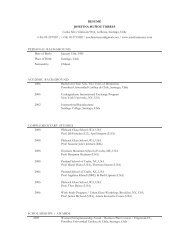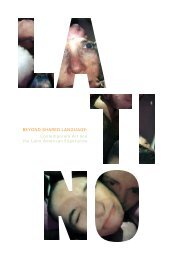BEYOND SHARED LANGUAGE - Society for Contemporary Craft
BEYOND SHARED LANGUAGE - Society for Contemporary Craft
BEYOND SHARED LANGUAGE - Society for Contemporary Craft
You also want an ePaper? Increase the reach of your titles
YUMPU automatically turns print PDFs into web optimized ePapers that Google loves.
THE ART OF CONTEMPORIZING CRAFT<br />
In 1995, the Salon de Arte Cubano Contemporáneo (organized by the National Council of Visual Arts)<br />
of Havana, Cuba granted the Prize of Curatorship to Dannys Montes de Oca <strong>for</strong> a project titled<br />
“El oficio del arte” (The <strong>Craft</strong> of Art). The proposal was supported by a trend in Cuban art, which<br />
recognized a “revival of craftsmanship,” with the focus on the production of carefully executed work.<br />
This trend saw an increase in the creation of beautiful objects, ready to be commercialized. The<br />
climate in Cuba at that time, while marked by its worst financial and social crisis of the century, saw<br />
the emergence of a new art market unique to generations of artists trained under the aegis of socialism.<br />
This arts revival, countercurrent to conceptual practices that had predominated in the previous<br />
decade—neo-Dadaist and neo-Fluxus artists who rejected the prevailing standards in anti-art cultural<br />
works—deepened a certain cynicism among avid, young artists who sought to sell their work to the<br />
highest bidder. (Hardly two years earlier, the exhibition “Cómprame y cuélgame” [Buy Me and Hang<br />
Me] had been realized, in which some who participated soon turned into stars, such as Kcho and Los<br />
Carpinteros—the Carpenters). Under this new market—the same economy that ruled in the rest of<br />
the world—young artists were <strong>for</strong>ced to become small entrepreneurs,“independent workers” according<br />
to the nomenclature used by the government. Having witnessed the end of an era, cultural institutions<br />
no longer offered necessary support; artists now had to manage on their own and develop skills enabling<br />
them to make beautified things to generate currency. The challenge was to integrate this practice, openly<br />
mercantile, in a discourse of cultural interest, so that the institutions could promote them.<br />
The artists’ response to this challenge varied from the metaphorical rescue of the crafts in terms of the<br />
postmodern aesthetic debate between “what’s cooked and what’s raw,” which favored the image over<br />
the narrative and the figural over the discursive (in other words, between cultured art and folk art);<br />
to the appropriation of historical-cultural values associated with these occupations, that could be<br />
advantageous towards social critic, politics or even ideology. For example, Los Carpinteros reintroduced<br />
woodworking combined with painting in autobiographical sculptures; a cynical exercise that culminated<br />
in their thesis, which was the simulation of an auction in which all works were sold. In contrast, Kcho<br />
used recycled materials and fiber to create sculptures with overlapping symbols of the Sacred (Afro-<br />
Cuban religions) and the Nation (the island, the flag and the star). The subtext was that popular<br />
religious practices had been labeled by Castro as superstition, and remnants of Capitalism that had to<br />
be eliminated. Other artists integrated crafts like plaster casting, ceramics, sewing and embroidering, in<br />
many cases alluding to their marginality within the economic socialist model.<br />
When Kate Lydon visited me at El Museo del Barrio several months ago, looking <strong>for</strong> in<strong>for</strong>mation on<br />
Latin American artists who used craft in their work, I noticed how different our views were on the<br />
subject.While she focused on the materials used (fiber, clay, glass, textiles, leather, paper), that is to say,<br />
in the aesthetic dimension of the phenomenon, I looked <strong>for</strong> the cultural and social resonances that<br />
these materials had within the poetic content of each artist, probably influenced by the Cuban<br />
experience of 1995.<br />
10




